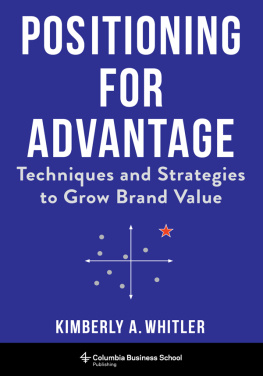
How Brands Grow
by Byron Sharp
e-Book Edition

Originally published in hardback by Oxford University Press
OXFORD is a trademark of Oxford University Press in the UK and in certain other countries
Copyright Byron Sharp 2010
First published 2010, reprinted 2010, 2011, 2012
Revised e-book version 2014
National Library of Australia Cataloguing-in-Publication entry Sharp, Byron.
How brands grow: what marketers don't know / Byron Sharp.
Includes bibliography.
ISBN 978 0 19 557356 5 (pbk)
1. Marketing. 2. Advertising. 3. Branding (Marketing). 4.Consumer Behavior. 5. Market Research.
658.83
Reviews of How Brands Grow

"Highly practical...includes many groundbreaking ideas."
CHOICE
More than anything else, Im just plain envious. Its a book I wish I had the intelligence to write....
Reading Sharp's critique of the cult of differentiation made me smile. And I laughed out loud at his characterisation of supposedly committed consumers as uncaring cognitive misers.
Marketing Week (UK)
"Marketers need to move beyond the psycho-babble and read this book... or be left hopelessly behind."
Joseph Tripodi, Chief Marketing & Commercial Officer
The Coca-Cola Company, Atlanta USA
"Until every marketer applies these learnings, there will be a competitive advantage for those who do."
Mitch Barns, CEO
The Nielsen Company
"A scientific journey that reveals and explains with great rigour the Laws of Growth."
Bruce McColl, Chief Marketing Officer
Mars Inc.
"This book puts marketing's myth-makers, of which there are many, in their proper place."
Thomas Bayne, CEO
MountainView Learning, London.
Author
Byron Sharp
Dr Byron Sharp is Professor of Marketing Science, and the Director of the Ehrenberg-Bass Institute, at the University of South Australia. The Ehrenberg-Bass Institute's research is used and financially supported by many of the world's leading corporations, including Coca-Cola, Colgate-Palmolive, First National Bank, General Motors, Procter & Gamble, Turner Broadcasting, ESPN, and Unilever.
Byron has published over 100 academic papers and is on the editorial board of five journals. He recently co-hosted with Professor Jerry Wind two conferences at the Wharton Business School on the laws of advertising, and co-edited the 2009 and 2013 special issues of the Journal of Advertising Research on scientific laws of advertising.
His university textbook Marketing: theory, evidence, practice (Oxford University Press) was released in 2013.
www.ByronSharp.com

Contributors
John Dawes
Dr John Dawes is Associate Professor at the Ehrenberg-Bass Institute, University of South Australia. John has an extensive background in sales and marketing prior to becoming an academic researcher. He has published in journals such as the Journal of Services Research , Wall Street Journal , International Journal of Market Research , and the Journal of Brand Management . John is the editor of the Journal of Empirical Generalisations in Marketing Science (EMPGENS) www.empgens.com .
www.JohnDawes.com.au
Jenni Romaniuk
Dr Jenni Romaniuk is Research Professor and Associate Director (International) of the Ehrenberg-Bass Institute, at the University of South Australia. Jenni's research covers brand equity, brand image tracking, how to use advertising to build brands, and how to understand and use the brand perception-behaviour link.
Jenni has published in journals such as the Journal of Business Research , Journal of Marketing Management , Marketing Theory , European Journal of Marketing , International Journal of Market Research , and the Journal of Financial Services Marketing . She is executive editor (International) of the Journal of Advertising Research . For the past ten years she has been providing research on brand strategy to companies in industries as diverse as retail, food, tourism, financial services, insurance, telecommunications, universities, event management and government departments.
www.JenniRomaniuk.com
John Scriven
John Scriven was previously director of the Ehrenberg Centre at London South Bank University. John specialises in the study of brand performance measures and the effects of marketing inputs, particularly price and advertising. He has over 20 years experience in marketing, market research and marketing planning having held marketing positions with three major corporations: United Biscuits, RJR/Nabisco and Pepsico.
Preface
Marketing is a creative profession. So is architecture: architects design masterpieces like the Taj Mahal and the Sydney Opera House, but architects use their creativity within a framework of physical laws. Architects must design buildings that will not collapse under their own weight or blow over in a breeze; they cannot choose to ignore the law of gravity, or hope their building is immune to the laws of physics.
Marketers, even senior marketing academics, like to say that there can be no laws concerned with marketing. These people argue that consumers are far too individual and unpredictable. Research has shown this is utter nonsense. This ill-founded belief stops academics doing their job and searching for law-like patterns in buying behaviour and marketing effects. It also allows marketers to carry on with 'anything goes' marketing plans. Imagine if architects designed 'anything goes' plans Let's build out of fairy-floss', 'Let's add another 68 floors!
Marketers argue with each other about things that have nothing to do with the creativity of the discipline; about things that should be known for certain. It's time for this to stop. This book reveals the predictable patterns in how buyers buy, and how sales grow things all marketers should know, not argue about.
These patterns are valuable knowledge. It's often thought that great marketing strategy is obvious with hindsight everyone can see what you did and copy you. This might be true for new products or some advertising campaigns, but in reality marketing offers the ability to outperform competitors while they scratch their heads wondering why on earth you are doing so well. Unfortunately, marketers themselves often have no idea why one of their own campaigns worked and others did not. Their explanations as to what they got right or wrong are often wide of the mark because their assumptions (the theories in their head) are wrong.
This book is for marketers who are willing to learn new things based on classical science, and to shake off the superstition (and unfounded speculation) that today passes for marketing theory.
Read the assumptions in Table 1.
Table 1: Marketing assumptions
| Strategic Assumptions | True, False, or Dont Know? |
| Differentiating our brand is a vital marketing task? |
| Loyalty metrics reflect the strength, not size, of our brand? |
| Customer retention is cheaper than acquisition? |

















